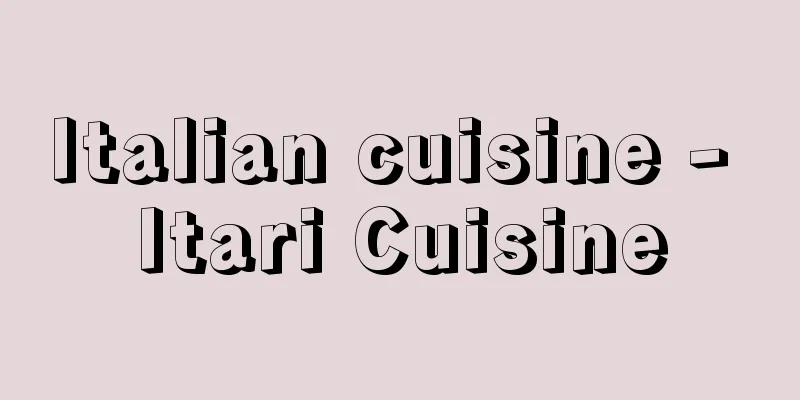Italian cuisine - Itari Cuisine

|
Italy lies at the center of the Mediterranean world, and has been a melting pot, so to speak, where various cultures have been introduced and fused since ancient times. Diverse cultures flourished in various parts of the country, including Etruscan, Greek, and Roman cultures in ancient times, and Byzantine and Arab cultures in the Middle Ages. As a result, Italian culinary culture has a long history and is diverse in content. The Romans in particular were a people who sought the true flavor of food, and were a people who would go to the extreme of extravagance in their evening banquets, known as quena. In the 9th century, Arabs, who had excellent agricultural techniques, took control of Sicily, and introduced cultivation methods for rice, sugar cane, saffron, and other crops. [Nobuo Nishimura] Tastes of the City-StatesFrom the Middle Ages to the Renaissance, city-states flourished in Italy, and their culinary cultures also took on their own characteristics: Venetian cuisine (for example, fish dishes such as squid ink and polenta made with corn flour), Lombardy cuisine (rice dish called risotto), Emilia-Romagna cuisine centered around Bologna (foods made with meat and milk such as salami sausage, sausage, and Parmesan cheese, and raw pasta such as ravioli and lasagna), Tuscan cuisine such as Florence, Siena, and Livorno (Florentine beefsteak and a mushroom dish called porcini), Ligurian cuisine centered around Genoa (pasta dishes made with pesto pesto), Lazio cuisine centered around Rome (meat dish called Roman saltimbocca and Roman gnocchi), Neapolitan cuisine (fish dish called zuppa di pesce, spaghetti and pizza with Neapolitan sauce), and Sicilian cuisine (pasta dish with sardines). The culinary culture that was the product of this urban civilization crossed the Alps and entered France. Until now, Western cuisine in Japan was thought of as French cuisine, but recently there has been a major re-evaluation of Italian cuisine, the origin of Western cuisine. [Nobuo Nishimura] Commonalities between Italian cuisineItalian cuisine is diverse, with its characteristics in each city and region, but it is not without commonalities and characteristics that run through the whole cuisine. One of these is tomato sauce called salsa di pomodoro, which is indispensable to Italian cuisine in general. Tomatoes that were brought to Italy after the discovery of the New World were cultivated mainly in Naples, and became excellent tomatoes with thick flesh and relatively little acidity and moisture. Another common ingredient is olive oil. Olive oil is an essential seasoning for Italian cuisine, and is used as a dressing for seafood salads called insalata marinara and vegetable salads. Grilled fish is also eaten with olive oil. Italian cuisine is characterized by making the most of the natural flavors of the ingredients, and for this reason, olive oil, which has a mild flavor of its own but has the power to bring out other flavors, plays an important role. [Nobuo Nishimura] Wines with regional flavourWine is also an essential element of Italian cuisine. As Bartolomeo Sacchi (1421-81), author of the cookbook On the Honourable Joys and Health, said, "A meal without wine is not only unenjoyable, but also unhealthy," Italians consider wine to be a fundamental element of a meal. There are many types of Italian wine, including Soave from Veneto, Barolo and Barbera from Piedmont, Borcevera from Liguria, Lambrusco from Emilia, Chianti from Tuscany, Frascati and Esto Esto Esto from Lazio, Lacrima Cristi from Campania, and Marsala and Corbo from Sicily. Over the course of their long history, these wines have all been made to perfectly match the cuisine of their region. In other words, the best way to enjoy Italian cuisine is to eat local cuisine with local wine. [Nobuo Nishimura] Eating habitsItalians are said to be a nation that eats a lot. In a full course meal, the stomach is stimulated moderately with an aperitif, followed by antipasto (appetizer), primo piatto (the first course, which is soup, pasta, or risotto), secondo piatto (the second course, which is a main dish of meat or fish), a vegetable dish or vegetable salad, cheese, sweets, fruit, coffee, and digestif. Bread and wine are served throughout the meal. However, such meals are often special occasions such as entertaining guests, and meals at ordinary homes are a little more modest. For a typical Italian meal, breakfast is a very simple meal of milk coffee and bread or cake, and lunch is relatively heavy, with soup or pasta, meat or fish, vegetable salad, fruit, cheese, sweets, coffee, etc. Dinner is basically the same as lunch, although it may be a little lighter if the lunch is heavy. Of course, in some cases, people may buy pizza from a pizza shop and have that as a meal. What is completely different from Japan is that the whole family eats lunch and dinner together. This is a custom that clearly shows how important food is in Italian life. [Nobuo Nishimura] [Reference] | |Source: Shogakukan Encyclopedia Nipponica About Encyclopedia Nipponica Information | Legend |
|
イタリアは地中海世界の中心にあって、古くからさまざまな文化が渡来し、融合した、いわば、るつぼのような所であった。古代ではエトルリア、ギリシア、ローマ、中世ではビザンティン、アラブなど多様な文化が各地で栄えた。そのため、イタリアの料理文化は歴史も古く、内容も多様である。なかでもローマ人は美味求真の民であり、ケーナとよばれる夕べの宴に、贅(ぜい)を尽くす民族であった。9世紀には優れた農業技術をもつアラビア人がシチリア島を支配し、イネ、サトウキビ、サフランなどの栽培法を伝えた。 [西村暢夫] 都市国家ごとの味中世からルネサンスにかけてイタリアでは都市国家が興隆し、料理文化もその都市国家ごとの特徴をもつようになる。すなわち、ベネチア料理(たとえばイカの墨煮などの魚料理やトウモロコシ粉を使ったポレンタ)、ロンバルディア料理(リゾットとよばれる米料理)、ボローニャを中心としたエミリア・ロマーニャ料理(サラミソーセージ、ソーセージ、パルメザンチーズなど肉やミルクを材料にした食品、ラビオーリ、ラザーニャなどの生(なま)パスタ)、フィレンツェ、シエナ、リボルノなどのトスカナ料理(フィレンツェ風ビフテキ、ポルチーニというキノコ料理)、ジェノバを中心としたリグリア料理(ソースのペースト・ジェノベーゼを使ったパスタ料理)、ローマを中心としたラツィオ料理(ローマ風サルティンボッカの肉料理やローマ風ニョッキ)、ナポリ料理(ズッパ・ディ・ペーシェという魚料理、ナポリ風ソースのスパゲッティやピッツァ)、シチリア料理(イワシ入りパスタ料理)などの誕生である。 そしてこれら都市文明の所産である料理文化が、アルプスを越えてフランスに入っていったのである。日本ではいままで、西洋料理といえばフランス料理と考えられていたが、最近では西洋料理の起源であるイタリア料理が大きく見直されている。 [西村暢夫] イタリア料理の共通項各都市、各地方ごとに特徴をもつ多様なイタリア料理にも、共通する面、全体を通しての特徴がないわけではない。その一つは、サルサ・ディ・ポモドーロとよばれるトマトソースで、イタリア料理全般に欠かすことのできないものである。新大陸発見後イタリアに入ったトマトは、ナポリを中心に栽培され、果肉が厚く酸味や水分の比較的少ない優れたものになった。もう一つの共通材料はオリーブ油である。イタリア料理の味つけにオリーブ油は欠かすことのできない調味料で、インサラータ・マリナーラとよばれる海の幸のサラダや、野菜サラダのドレッシングに用いられる。焼き魚にもオリーブ油をかけて食べる。材料の持ち味をなるべく生かして食べるのがイタリア料理の特色であり、そのためにも、自身の味はやさしく、むしろ他の味を引き出す力のあるオリーブ油が一役も二役も買っている。 [西村暢夫] 地方色のあるワインワインもイタリア料理には欠かせない要素である。『尊ぶべき喜びと健康について』という料理書を著したバルトロメオ・サッキ(1421―81)が、「ワインのない食事は楽しくないばかりか健康によくない」といっているように、イタリア人はワインを食事の基本要素と考えている。イタリアのワインには、ベネトのソアーベ、ピエモンテのバローロやバルベラ、リグリアのボルチェベラ、エミリアのランブルスコ、トスカナのキアンティ、ラツィオのフラスカーティやエスト・エスト・エスト、カンパニアのラクリマ・クリスティ、シチリアのマルサラやコルボなど多種多様である。そしてこれらのワインは、長い歴史のなかで、すべてその土地の料理にぴったりあうようにできている。つまり、地酒でその土地の料理を食べるのが、イタリア料理のいちばんおいしい食べ方なのである。 [西村暢夫] 食事の習慣イタリア人はよく食べる国民であるといわれている。フルコースでは、まず食前酒で胃を適度に刺激し、アンティパスト(前菜)、プリモ・ピアット(第一の料理で、ここでスープあるいはパスタ類、またはリゾットが出る)、セコンド・ピアット(第二の料理で、肉や魚のメイン料理が出る)、それに取り合わせの野菜料理や野菜サラダ、それからチーズ、菓子、果物、コーヒー、食後酒と続く。食事中はパンとワインが最初から最後までついている。ただし、このような食事はお客を接待するような特別の場合が多く、普通の家庭の食事はもう少しつつましい。イタリア人の普通の食事は、朝食はミルクコーヒーにパンかケーキのごく簡単なもので、昼食は比較的重く、スープかパスタ類、それに肉か魚、野菜サラダ、果物、チーズ、菓子、コーヒーなどをとる。夕食は、昼が重ければ少し軽くする程度で、基本的には昼食と変わらない。もちろん場合によっては、ピッツァ屋からピッツァを買ってきて、それで一食すませることもある。日本と完全に違うのは昼食も夕食も家族全員がそろって食事をすることである。これはイタリア人が生活のなかで食事をいかにたいせつにしているかよくわかる習慣である。 [西村暢夫] [参照項目] | |出典 小学館 日本大百科全書(ニッポニカ)日本大百科全書(ニッポニカ)について 情報 | 凡例 |
<<: Italian ryegrass - Italian ryegrass
>>: Italian Literature - Italian Literature
Recommend
Mr. Ishigami - Isonokamiuji
One of the powerful clans of ancient times. Origin...
Collection of the Deities' Wishes - Shoshinhonkaishu
A Buddhist Shinto book. Written in 1324 by Sonkaku...
Europe - Europe (English spelling)
The Key to Understanding Europe: Christianity Whe...
Caricature - Fushiga
A genre of manga. If we were to define manga, we ...
Paleoparadoxia
A genus of mammals that existed in the middle Mioc...
Snake skin line - Jabisen
〘Noun〙 A colloquial name for the sanshin, a typica...
Secret savings - Secret savings
Hesokuri generally refers to assets that are priva...
Spartina
...Garden grasses are also grasses of the grass f...
False cavity - Giku
In arterial dissection and aortic dissection, a bl...
neodymium
Nd. Atomic number 60. Electron configuration [Xe]...
Labor turnover
This refers to the movement of people who are the...
The Truce of God
A measure proposed by the Roman Church in medieval...
Abraha - Oil
...Yakut geography records that the huge Ghumdan ...
Mezhdunarodnoe ob'edinenie revolyutsionnykh pisatelei (English spelling)
...An international organization for proletarian ...
Koto score - Kinfu
...In China after the Xinhai Revolution, the use ...









